1. Baik I. Forecasting obesity prevalence in Korean adults for the years 2020 and 2030 by the analysis of contributing factors. Nutr Res Pract. 2018; 12:251–257. PMID:
29854331.

2. Behl S, Misra A. Management of obesity in adult Asian Indians. Indian Heart J. 2017; 69:539–544. PMID:
28822528.

3. Chang E, Kim CY. Natural products and obesity: a focus on the regulation of mitotic clonal expansion during adipogenesis. Molecules. 2019; 24:1157.

4. Choe SS, Huh JY, Hwang IJ, Kim JI, Kim JB. Adipose tissue remodeling: its role in energy metabolism and metabolic disorders. Front Endocrinol (Lausanne). 2016; 7:30. PMID:
27148161.

5. Rosen ED, MacDougald OA. Adipocyte differentiation from the inside out. Nat Rev Mol Cell Biol. 2006; 7:885–896. PMID:
17139329.

6. Kim CY, Le TT, Chen C, Cheng JX, Kim KH. Curcumin inhibits adipocyte differentiation through modulation of mitotic clonal expansion. J Nutr Biochem. 2011; 22:910–920. PMID:
21189228.

7. Moseti D, Regassa A, Kim WK. Molecular regulation of adipogenesis and potential anti-adipogenic bioactive molecules. Int J Mol Sci. 2016; 17:124.

8. Ha JH, Jang J, Chung SI, Yoon Y. AMPK and SREBP-1c mediate the anti-adipogenic effect of β-hydroxyisovalerylshikonin. Int J Mol Med. 2016; 37:816–824. PMID:
26865314.

9. Thomas SS, Kim M, Lee SJ, Cha YS. Antiobesity effects of purple perilla (perilla frutescens var. acuta) on adipocyte differentiation and mice fed a high‐fat diet. J Food Sci. 2018; 83:2384–2393. PMID:
30070698.
10. Lee JW, Kang YJ. Anti-inflammatory effects of Abeliophyllum distichum flower extract and associated MAPKs and NF-κB pathway in raw264.7 cells. Korean J Plant Resour. 2018; 31:202–210.
11. Jang TW, Park JH. Antioxidant activity and inhibitory effects on oxidative DNA damage of callus from Abeliophyllum distichum Nakai. Korean J Plant Resour. 2018; 31:228–236.
12. Park GH, Park JH, Eo HJ, Song HM, Woo SH, Kim MK, Lee JW, Lee MH, Lee JR, Koo JS, Jeong JB. The induction of activating transcription factor 3 (ATF3) contributes to anti-cancer activity of Abeliophyllum distichum Nakai in human colorectal cancer cells. BMC Complement Altern Med. 2014; 14:487. PMID:
25494848.

13. Kim EY, Kim JH, Kim M, Park JH, Sohn Y, Jung HS. Abeliophyllum distichum Nakai alleviates postmenopausal osteoporosis in ovariectomized rats and prevents RANKL-induced osteoclastogenesis in vitro. J Ethnopharmacol. 2020; 257:112828. PMID:
32268206.

14. Eom J, Thomas SS, Sung NY, Kim DS, Cha YS, Kim KA. Abeliophyllum distichum ameliorates high-fat diet-induced obesity in C57BL/6J mice by upregulating the AMPK pathway. Nutrients. 2020; 12:3320.
15. Kim M, Park JE, Song SB, Cha YS. Effects of black adzuki bean (Vigna angularis) extract on proliferation and differentiation of 3T3-L1 preadipocytes into mature adipocytes. Nutrients. 2015; 7:277–292. PMID:
25569623.

16. Gwon SY, Ahn JY, Jung CH, Moon BK, Ha TY. Shikonin suppresses ERK 1/2 phosphorylation during the early stages of adipocyte differentiation in 3T3-L1 cells. BMC Complement Altern Med. 2013; 13:207. PMID:
23919458.

17. Stern JH, Rutkowski JM, Scherer PE. Adiponectin, leptin, and fatty acids in the maintenance of metabolic homeostasis through adipose tissue crosstalk. Cell Metab. 2016; 23:770–784. PMID:
27166942.

18. Yoo TK, Kim JS, Hyun TK. Polyphenolic composition and anti-melanoma activity of white forsythia (Abeliophyllum distichum nakai) organ extracts. Plants (Basel). 2020; 9:757.

19. Sun L, Yu F, Yi F, Xu L, Jiang B, Le L, Xiao P. Acteoside from Ligustrum robustum (Roxb.) blume ameliorates lipid metabolism and synthesis in a HepG2 cell model of lipid accumulation. Front Pharmacol. 2019; 10:602. PMID:
31178740.

20. Rosen ED, Hsu CH, Wang X, Sakai S, Freeman MW, Gonzalez FJ, Spiegelman BM. C/EBPalpha induces adipogenesis through PPARgamma: a unified pathway. Genes Dev. 2002; 16:22–26. PMID:
11782441.
21. Tang QQ, Otto TC, Lane MD. CCAAT/enhancer-binding protein β is required for mitotic clonal expansion during adipogenesis. Proc Natl Acad Sci U S A. 2003; 100:850–855. PMID:
12525691.

22. Hishida T, Nishizuka M, Osada S, Imagawa M. The role of C/EBPdelta in the early stages of adipogenesis. Biochimie. 2009; 91:654–657. PMID:
19233245.
23. Hishida T, Eguchi T, Osada S, Nishizuka M, Imagawa M. A novel gene, fad49, plays a crucial role in the immediate early stage of adipocyte differentiation via involvement in mitotic clonal expansion. FEBS J. 2008; 275:5576–5588. PMID:
18959745.

24. Oh JH, Karadeniz F, Lee JI, Seo Y, Kong CS. Artemisia princeps inhibits adipogenic differentiation of 3T3-L1 pre-adipocytes via downregulation of PPARγ and MAPK pathways. Prev Nutr Food Sci. 2019; 24:299–307. PMID:
31608255.

25. Pal M, Febbraio MA, Lancaster GI. The roles of c-Jun NH2-terminal kinases (JNKs) in obesity and insulin resistance. J Physiol. 2016; 594:267–279. PMID:
26608096.

26. Takenouchi T, Takayama Y, Takezawa T. Co-treatment with dexamethasone and octanoate induces adipogenesis in 3T3-L1 cells. Cell Biol Int. 2004; 28:209–216. PMID:
14984747.

27. Nam SY, Kim HY, Yoou MS, Kim AH, Park BJ, Jeong HJ, Kim HM. Anti-inflammatory effects of isoacteoside from Abeliophyllum distichum. Immunopharmacol Immunotoxicol. 2015; 37:258–264. PMID:
25975581.
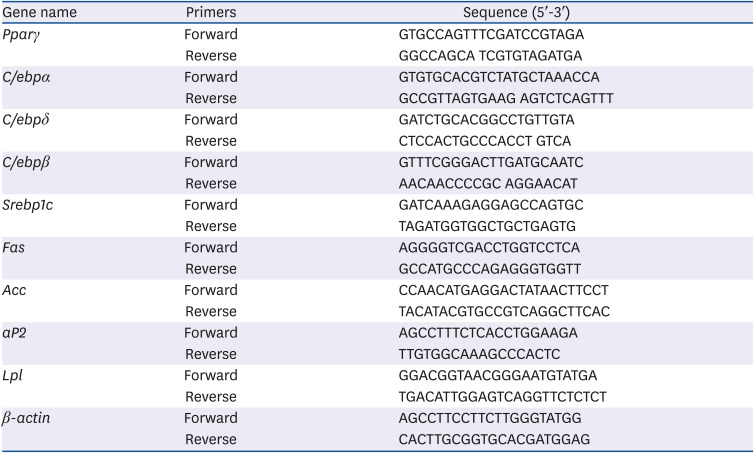
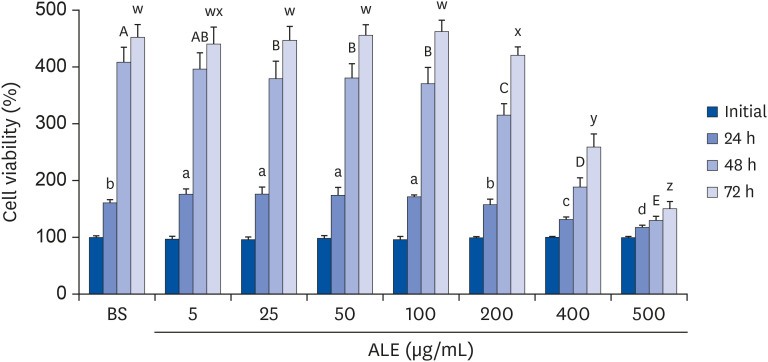
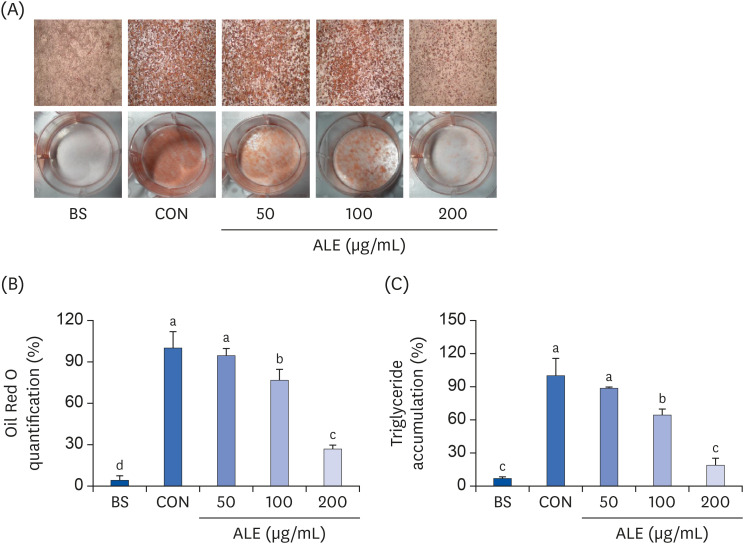
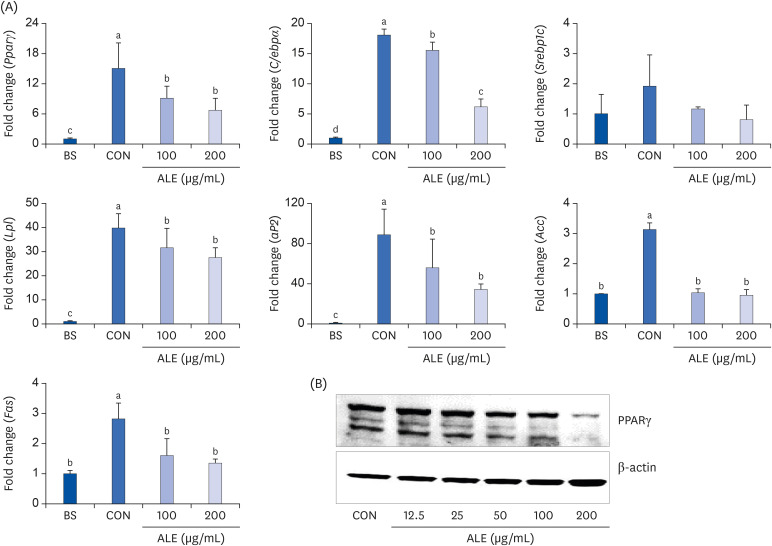
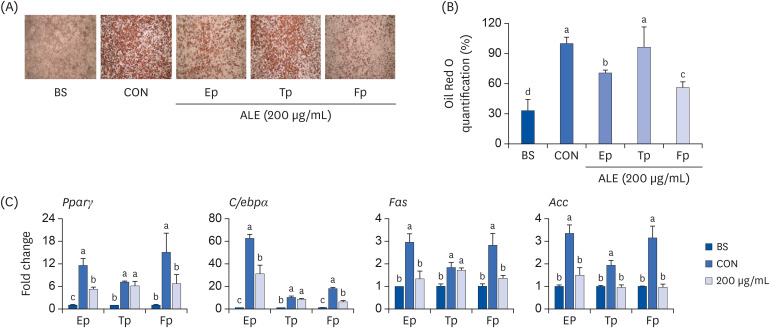
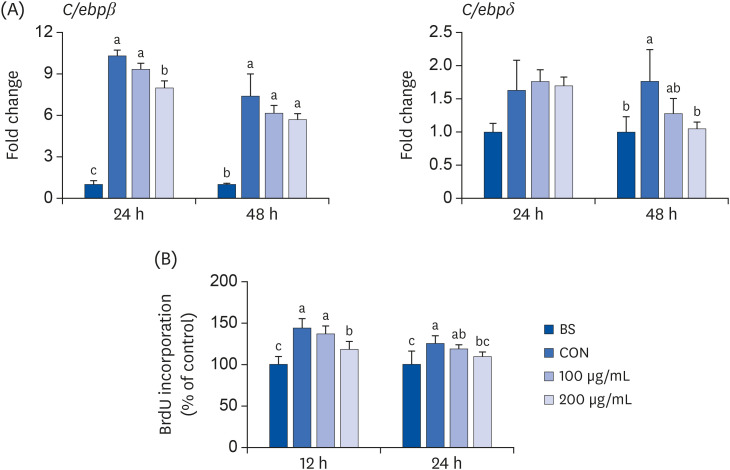
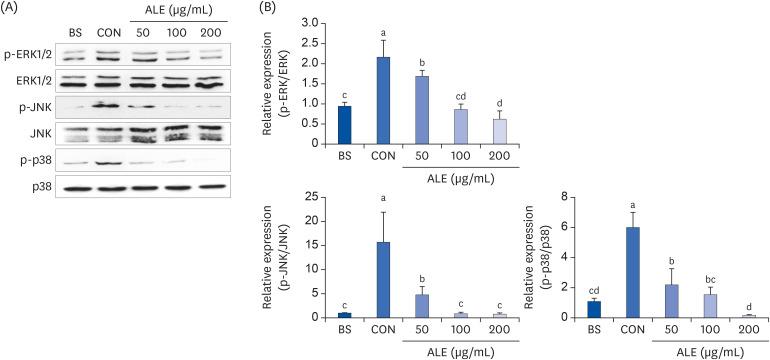




 PDF
PDF Citation
Citation Print
Print



 XML Download
XML Download